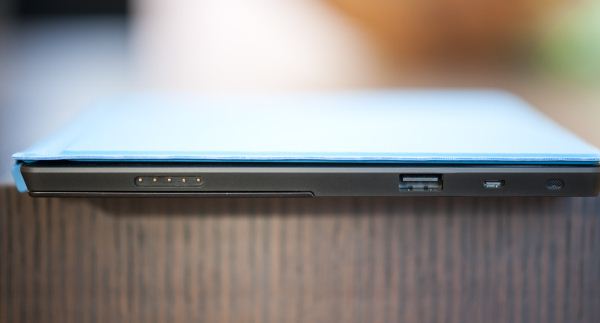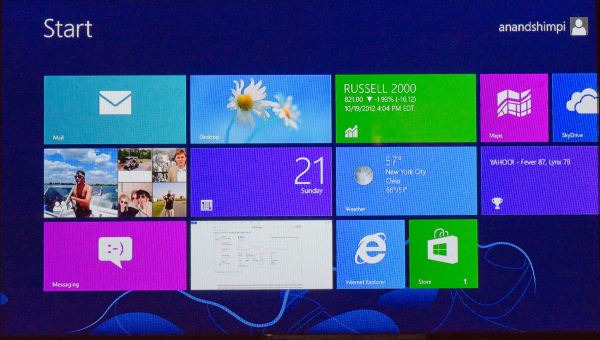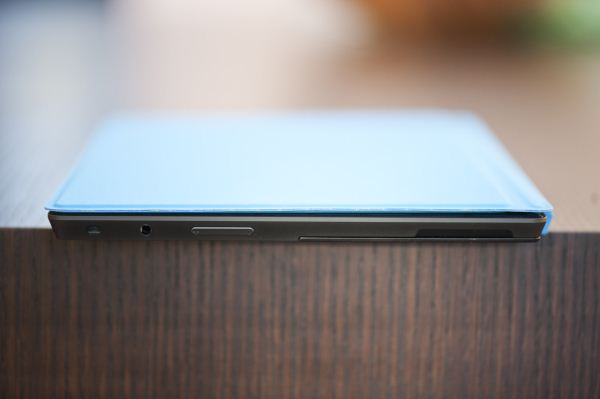Microsoft Surface Review
by Anand Lal Shimpi on October 23, 2012 9:01 PM EST- Posted in
- Tablets
- Microsoft
- Mobile
- Surface
- Windows RT
A Plethora of Ports and Storage Options
One area where Surface is a significant departure from the iPad is in its IO and expansion. The iPad features a single dock (and soon to be Lightning) connector, while Surface looks more like a laptop (or Android tablet) when it comes to IO.
There’s no port for syncing, you get content onto Surface via WiFi or a more traditional method. Surface has a single USB 2.0 port on the right side of the device. You can plug almost anything you want into this port, including USB storage devices of course. Behind the kickstand is a single microSD card slot, giving you another option for expansion.
On the left edge of the device there’s a micro-HDMI out port that can be paired with a Microsoft made VGA or HDMI dongle (both dongles have a 22-degree connector on them to mate flush with Surface). I tested HDMI output with Microsoft's dongle and unfortunately the result wasn't very good. The 1080p output had a lot of issues with scaling quality (as you can see from the shot below) and there was a lot of tearing on the screen with a big impact on UI frame rate. I reached out to Microsoft for an explanation but have yet to hear anything.
Finally there’s a standard 1/8” headphone jack along the top of the device.
Power delivery comes via a custom magnetic connector along the lower right side of Surface.
Given that the internal storage is an eMMC solution, performance from the microSD slot with a good card should be fairly comparable. In practice I could read and write a large sequential file at roughly 10.5 MB/s using a SanDisk microSD card.
Copying from a fast USB stick to Surface’s internal storage gave me transfer rates closer to 17MB/s. There are a few vendors for Windows 8/RT eMMC devices, I’ll be paying close attention over the coming weeks to figure out who makes the best. I know Microsoft and Intel (among others) have been playing close attention to the eMMC providers with hopes of weeding out those that deliver honestly unacceptable performance.
While doing background file IO I didn’t notice any of the stalling/pausing that we’ve seen on some of the more recent Android tablets.
Update: Many have asked about how much storage is taken up by the Windows + Office 2013 installs. The screenshot below shows the directory size for both C:\Windows and C:\Program Files, the latter is where the Office15 install files are included (and yes winword.exe is still the Word executable).
You're looking at roughly 6.47GB for Windows RT and then another 830MB for Office for a grand total of around 7.3GB.
USB Compatibility
Microsoft is particularly proud of its single USB 2.0 port on Surface. Although USB ports have been featured on several Android tablets, their support was typically limited to flash drives, keyboards and mice. With Windows RT, Microsoft wants to bring more of the traditional Windows experience to tablets. Had Surface been x86 based, you would be able to plug in virtually any USB peripheral and it would just work. As the first version of Surface is based on an ARM SoC, driver support is a little more limited but still pretty decent.
USB drives obviously work as you’d expect them to. Even SATA to USB adapters worked fine when plugged into Surface. Other smartphones and tablets also worked, although their level of support varied. For example, you can plug in the iPhone 5 and have it come up as a supported device for moving pictures to/from. However USB tethering is not supported by the class driver included in Windows RT. You can even plug an iPad into Surface and get the same level of support.
Printer support is pretty decent, although the Epson Workforce 910 I tried didn’t actually have specific driver support under RT. Although development for the desktop side of Windows is limited, manufacturers can supply Windows RT drivers to enable support for some more obscure devices. Unfortunately when it comes to those devices you’ll have to play the waiting game as there’s simply not a lot of third party Windows RT drivers available for download today.






_575px.png)








235 Comments
View All Comments
MadMan007 - Tuesday, October 23, 2012 - link
Nice article, but something struck me as odd after getting a bit into it - why do you refer to this device as 'Surface' as if it's a person instead of 'THE Surface' like every other device? Are we going to start seeing reviews saying 'I like Macbook's new screen'?melgross - Wednesday, October 24, 2012 - link
Apple does the same thing with the iPad, simply referring to is as iPad. I don't understand this either, but it's their choice.jjj - Tuesday, October 23, 2012 - link
pushing the positive spin quite a bit on this one.NO ecosystem, buggy software ,can't be used with the keyboard on your lap like the Transformer or any laptop,poor keyboard , high price,the software takes a lot of the advertised storage,access to only one app store and bulky hardware.
guidryp - Wednesday, October 24, 2012 - link
Yeah. I read several other reviews (Verge, Wired, Tech Crunch) and this one seems like a whitewash in comparison.Most point out that there is very little software and most of it is buggy. They also mention how uncomfortable it is to use as a tablet.
Half assed as a tablet.
Half assed as laptop.
Very little software...
Buggy
For MS/Windows fans, at least get yourself an x86 so you can run real Windows software to cover the deficiencies.
doobydoo - Wednesday, October 24, 2012 - link
Did I miss the CPU / GPU benchmarks section, which generally come with every tablet review?tipoo - Wednesday, October 24, 2012 - link
There probably aren't that many that can be run outside of a web browser for it, the app store is pretty sparse right now.michal1980 - Wednesday, October 24, 2012 - link
Anand is showing that he cares far less about MS now then apple.kyuu - Thursday, October 25, 2012 - link
Nope. But there's not much benchmarking software that can be run on WindowsRT, outside of web-based ones. Plus, Tegra 3 is a pretty known quantity at this point.trexpesto - Tuesday, October 23, 2012 - link
one heck of a drop test 30,000 feet!glynor - Tuesday, October 23, 2012 - link
So... I'm seeing mixed information out there. The port looks like a regular micro-HDMI port. But Microsoft seems to call it a proprietary port in their marketing, and they sell the adapter.But PC Mag says they used an off-the-shelf micro-HDMI adapter and it worked.
But then, you got terrible (I'd call it unusable) quality out of their adapter.
What's going on here?